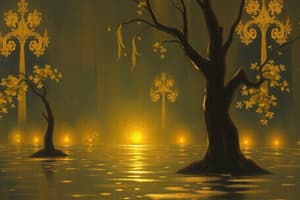Podcast
Questions and Answers
आईऑनिक रिश्तों की मुख्य विशेषता क्या है?
आईऑनिक रिश्तों की मुख्य विशेषता क्या है?
- सुगमता
- पानी में विलीन होना (correct)
- सबसे कम melting point और boiling point
- मलामिक कक्ष्मा उत्पन्न करना
किस सादा मानक मदेन से आईऑनिक रिश्तों का लैटिस ऊर्जा की मात्रा का अनुमान लगाने की प्रक्रिया प्रदान करता है?
किस सादा मानक मदेन से आईऑनिक रिश्तों का लैटिस ऊर्जा की मात्रा का अनुमान लगाने की प्रक्रिया प्रदान करता है?
- Rutherford model
- Bohr model
- Dalton's atomic theory
- Born-Haber cycle (correct)
20वीं सदी की प्रारंभिक परिप्रेक्ष्य में कौन-कौनसे सिद्धांतों का सहारा लिया गया था ionic bonding का मूल सिद्धांत समझने के लिए?
20वीं सदी की प्रारंभिक परिप्रेक्ष्य में कौन-कौनसे सिद्धांतों का सहारा लिया गया था ionic bonding का मूल सिद्धांत समझने के लिए?
- Quantum mechanics
- Electron theory
- Both a and b (correct)
- Newton's laws
कौन-सा सरल मॉडल chemists को bond formation और ionic compounds की गुणों की पूर्वानुमान करने में मदद करता है?
कौन-सा सरल मॉडल chemists को bond formation और ionic compounds की गुणों की पूर्वानुमान करने में मदद करता है?
कौन-सी संरचना ionic compounds के बीच में मजबूत electrostatic forces होती है?
कौन-सी संरचना ionic compounds के बीच में मजबूत electrostatic forces होती है?
कौन-सा तत्व मेटल्स से संगत होता है जो इलेक्ट्रॉन की खोज करता है और जो इयों बनाने में मदद करता है?
कौन-सा तत्व मेटल्स से संगत होता है जो इलेक्ट्रॉन की खोज करता है और जो इयों बनाने में मदद करता है?
आयनीक संयोजन क्या कहलाता है?
आयनीक संयोजन क्या कहलाता है?
आपसी परस्पर क्रिया के कारण क्या उत्पन्न होता है?
आपसी परस्पर क्रिया के कारण क्या उत्पन्न होता है?
'NaCl' में, 'Cl⁻' आयन कितने 'Na⁺' आयनों के चारों ओर स्थित होता है?
'NaCl' में, 'Cl⁻' आयन कितने 'Na⁺' आयनों के चारों ओर स्थित होता है?
'सोडियम सल्फेट' (Na₂SO₄) में, Na⁺ and SO₄²⁻ ionic compounds किस type की lattice structure format क्रियान्वित होती है?
'सोडियम सल्फेट' (Na₂SO₄) में, Na⁺ and SO₄²⁻ ionic compounds किस type की lattice structure format क्रियान्वित होती है?
Study Notes
Unraveling Ionic Bonds: A Foundation of Chemical Bonding
Chemical bonding, an essential concept in chemistry, encompasses the interactions that lead to the formation of molecules, ions, and crystals. One of the two primary types of bonds is ionic bonding, which plays a substantial role in our understanding of chemical structure and reactivity.
Ionic Bonds: The Basics
Ionic bonds form between atoms with a significant difference in electronegativity, leading to the transfer of electrons and the creation of oppositely charged ions. Metals, typically with a low ionization energy and a tendency to lose electrons, react with non-metals, which have a high electron affinity and a propensity to gain electrons.
Formation and Properties of Ionic Compounds
When a metal and a non-metal react, the metal loses electrons to form cations, while the non-metal gains electrons to form anions. The electrostatic attraction between oppositely charged ions gives rise to ionic compounds, such as sodium chloride (NaCl) or calcium sulfate (CaSO₄).
In ionic compounds, the lattice structure is essential. For example, sodium chloride (NaCl) forms a cubic close-packed lattice, with each sodium ion (Na⁺) surrounded by six chloride ions (Cl⁻) and vice versa, creating a three-dimensional framework.
Ionic Bonding in Context
Ionic bonding frequently occurs in inorganic compounds, such as salts, and contributes significantly to the properties of these substances. Ionic compounds are generally soluble in water, form crystalline solids, and have high melting and boiling points due to the strong electrostatic forces between ions.
Ionic Bonding: A Historical Perspective
The concept of ionic bonding emerged during the early 20th century, with chemists incorporating ideas from electron theory and quantum mechanics to explain the structure and properties of ionic compounds.
Ionic Bonding: A Simplified Approach
Though a quantitative understanding of ionic bonding requires detailed models and calculations, chemists often use simplified models to predict bond formation and the properties of ionic compounds. For example, the Born-Haber cycle provides a method to estimate the lattice energy of ionic compounds from experimental data.
Conclusion
Ionic bonds are a fundamental part of chemical bonding, contributing to the properties and behavior of various substances. Understanding ionic bonding helps chemists predict the properties of new compounds and design materials with specific characteristics. As a result, ionic bonding remains a cornerstone of chemistry curriculum and research.
Studying That Suits You
Use AI to generate personalized quizzes and flashcards to suit your learning preferences.
Description
Explore the basics of ionic bonding, the formation and properties of ionic compounds, and the historical perspective on this essential concept in chemistry. Learn how ionic bonding contributes to the structure, properties, and behavior of various substances, providing a foundation for understanding chemical bonding.




